Modulation is a core element of almost every sound from vocals to guitar but it comes in a variety of guises. We examine the warps and whoops of musical life…
Modulation is the process of changing an aspect of a sound such as pitch or volume. The changes can be small and subtle, wide-ranging and extreme, regular or irregular, fast or slow, and under the modulation umbrella lurk a vast range of processes and effects. The modulation effect we’re most familiar with is vibrato which is a gentle varying of the pitch but modulation can be applied to many sound parameters to create many effects.
In a synthesiser, modulation is typically applied via an LFO and the sine wave is the most common choice of waveform. This creates a regular, undulating modulation which, at low levels, is very pleasing.
The most musical vibrato, for example, occurs between 6-8Hz and the change in pitch should only be small, typically less than a quarter of a semitone. You can’t stray too far away from these settings without the sounding becoming distinctly unmusical. If you increase the pitch range, the gentle oscillation becomes a siren. If you increase the modulation rate, the vibrato becomes a buzz.
Shake it a baby…
Tech terms
LFO
Low Frequency Oscillator, an oscillator designed to generate at a low frequencies and most commonly used to modulate other parameters.
Phase cancellation
When two signals of the same frequency are out of phase with each other (that is, their waveforms don’t start at the same time), parts of the signal will be cut resulting in a drop in amplitude.
Harmonic series
The harmonics produced by a fundamental note that have a simple mathematical relationship to the fundamental frequency. If the fundamental was 110Hz (the A an octave below Middle C), the harmonics would be 220Hz, 330Hz, 440Hz, 550Hz and so on. Harmonics whose mathematical relationship to the fundamental is more complex – such as 121Hz, 309Hz and 499Hz – produce a more dissonant sound.
Another popular modulation is tremolo which is often confused with vibrato. Whereas vibrato is applied to the pitch of a sound, tremolo is applied to its volume or amplitude to create small crescendos and diminuendos. Again, small and subtle is musical, large and wide is not. Tremolo is particularly effective with metallic instrument sounds such as vibes and bells.
It’s worth pointing out that some instrument manufacturers confuse the two. The prime example is the tremolo arm on a guitar which stretches the strings creating a type of vibrato, not tremolo. However, other than the technical difference between the two effects, they can sound similar.
The Modulation Wheel on synthesisers and keyboards is used to apply – yes, you guessed – modulation to a sound.

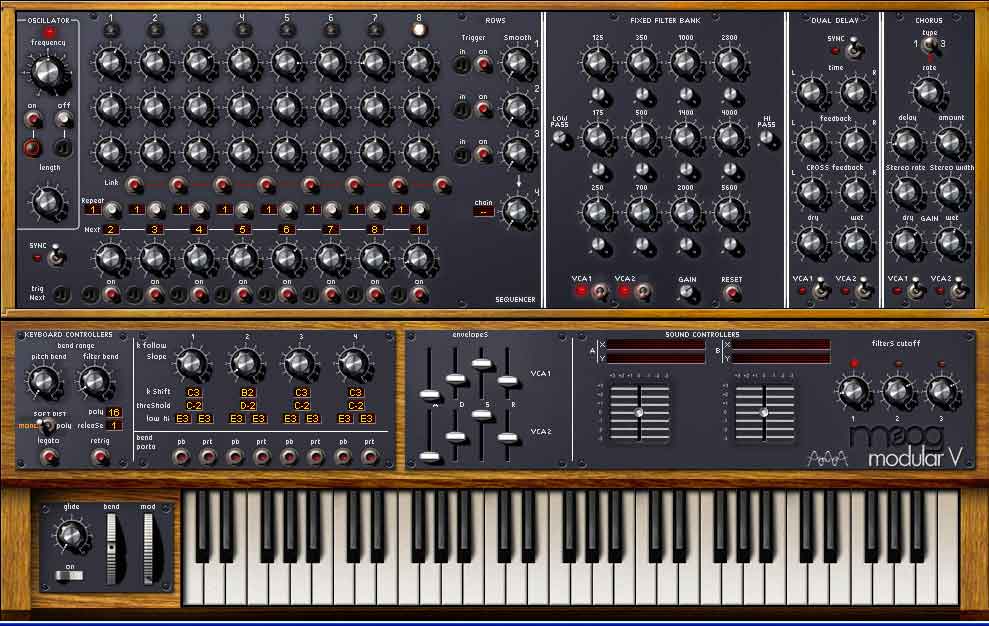
On most instruments the modulation is set to create vibrato by default and the more you move the wheel the greater the vibrato effect. However, particularly on synthesisers, you may be able to assign the Wheel to one of many parameters to create other effects. In such cases, the modulation may not be acting directly on pitch or volume but on a synth parameter such as the filter’s cutoff frequency to create tonal changes.
Vibrato can also be applied directly to some non-electronic instruments, primarily string instruments and the voice. Most Western vocalists, consciously or unconsciously, add a little vibrato to their voice to make it warmer and more appealing.
That’s not necessarily the case in other parts of the world. Listen to African singers, particularly tribal chants, and you’ll notice a marked lack of vibrato which makes the result quite distinctive. Karl Jenkins uses this to good effect in his Adiemus recordings which feature the voice of Miriam Stockley. But even if vocalists in a choir do not use vibrato, the result is still a warm sound – a chorus effect – which is still a modulation but created in a slightly different way.
Soft mod
So, we have a natural or manual modulation such as vibrato that can be applied directly to the instrument as it is being played, and we have an electronic modulation that is applied to a sound during its creation or during the performance.

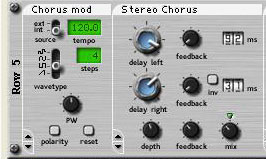
There are now so many ways of messing with a sound that it’s not always clear or obvious how an effect has been created. In a soft synth or a sequencer’s plug-in list you’ll often see effects you may not necessarily think of as modulation grouped into the modulation category. It’s commonly used as a catchall for effects that don’t fit neatly into other categories such as filter, reverb, delay, dynamic and so on.
In practice the category doesn’t really matter, but if you know how an effect is produced, you’ll know what’s happening when you twiddle the controls and be better able to decide what sort of effect you need if you’re looking for a particular sound.
All together now
The most common processed modulation effect is chorus so let’s see how that’s produced. A natural chorus, as mentioned above, is created when several similar, but not identical, sounds are played at the same time.


Even though singers and instrumentalists such as the string section of an orchestra, try to play together and in tune, there are very small differences between them in the tuning, tone and timing and these produce an ensemble or chorus effect.
An electronic chorus effect tries to create a chorus from a solo sound by applying many small, constantly-changing delays, typically around 40-50ms, to the signal and varying their pitch. The result is unlikely to turn a solo singer into a choir or a string line into a string orchestra but the effect is very good for ‘thickening’ a sound and giving it more substance. The main controls in a chorus unit control the speed and depth of the effect but you may see a whole range of parameters tacked on to a software chorus effect including filter controls to make the sound ‘sparkle’.
On the edge
While a chorus unit tries to duplicate a natural effect electronically, other modulation effects such as flanging and phasing are purely electronic.

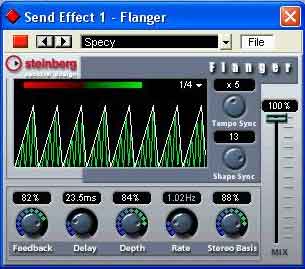
To create flanging electronically, you delay the signal by a few milliseconds and mix it back with the original. By varying the delay with an LFO you can control the sweep effect.
Other parameters may include rate which controls the speed, and feedback which may make the sound sharper or more metallic.
Phasing
Phasing is very similar to flanging and not many people can listen to an effect and say whether it’s one or the other so full marks to you if you can. Rumour has it that phasing was the first attempt to create the flanging sound electronically, but there’s no need to get hung up on the history.
In essence, phasing uses a narrow bandwidth filter. The source signal is split in two, one half is passed through the filter, phase shifting is introduced around the central frequency then it’s mixed back with the original. This produces phase cancellations in the output and the whooshing sound is created by moving the filter up and down the frequency spectrum. Voila!

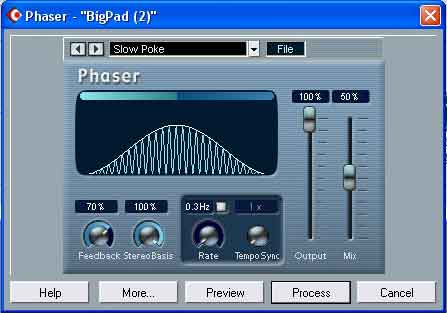
Phasing and flanging played a major part in many records during the late 60s and 70s. The one everyone remembers – even if they weren’t around at the time – is the Small Faces’ Itchycoo Park.

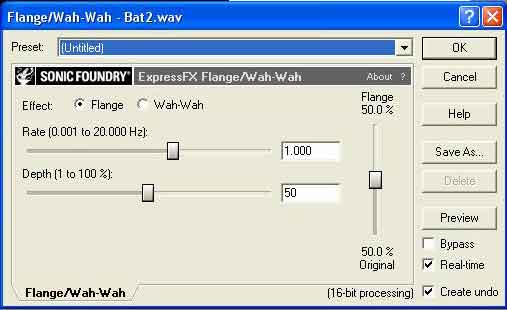
Phasing and flanging are excellent effects for adding interest to a sound. They are not as heavy as a filter sweep and can be applied to delicate sounds such as strings and vocals as well as to heavy guitar and synth sounds.
Ring-a-ding
Although these are the most common and popular modulation effects, there are many others. They include ring modulation, for example, which is traditionally a synthesiser effect but models have been developed to work with audio. Ring modulation takes two inputs and creates an output that is the sum of and difference between the frequencies of the two signals. Because of the mathematical way the signals are combined, the output frequencies are rarely part of the harmonic series and the result often sounds metallic.
Another effect usually found in the modulation category is the rotary speaker, based upon the Leslie speaker cabinet which was ubiquitously used with Hammond organs which were an essential, if heavy, part of every rock band in the 60s and 70s.

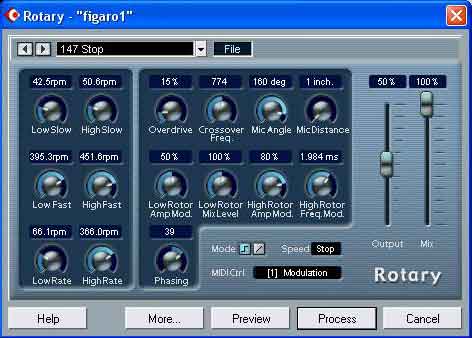
The original Leslie used rotating speakers to create a complex doppler effect that has become one of the most distinctive sounds in popular music. The doppler effect occurs when a sound moves towards and then away from the listener making the pitch rise and fall. Rotary speakers create a swirling chorus-like effect. Obviously, it’s de rigour to use with a Hammond organ sound but you can run any instrument through it and at gentle levels it can be used for subtle effects with vocals and other light sounds.
Modulation, in its many forms, is now an essential part of modern music and can be used to enhance, thicken and enliven just about any sound from synthesised and acoustic sounds to vocals.
For more info…
Time-varying delay effects, also an excellent source of synth and processing info.
Harmonic series:
http://www.sfu.ca/sonic-studio/handbook/Harmonic_Series.html
Phase cancellation:
BBC – excellent and easy-to-understand video explanation.
Open University – also excellent, with diagrams and audio.
Leslie speakers:
http://theatreorgans.com/hammond/faq/mystery/mystery.html









